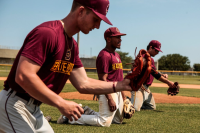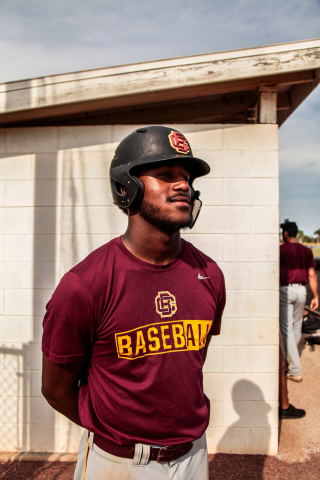Billy Witz
beeditors@blackenterprise.com
(Black PR Wire) DAYTONA BEACH, Fla. — Before each game, Clarence Carter III glances across the diamond as the opposing team warms up. He peeks in the dugout, scans the outfield and takes inventory around the infield during batting practice, counting how many African-Americans he can spot on the other team.
This is not an unusual drill for African-Americans playing in the major leagues, where their numbers have dwindled in recent decades, or in the similarly exclusive world of youth travel baseball.
But what makes this exercise striking is that Carter, a junior infielder at Bethune-Cookman University, plays for — and often against — one of America’s historically black colleges.
“It did catch me by surprise; I’m not going to lie,” said Carter, who transferred to Bethune-Cookman from a community college in Fullerton, Calif. “I would have thought coming to an H.B.C.U. there would be more black people, but things aren’t always what you expect.”
While baseball’s struggles to attract African-American talent and fans are well documented, the depth of the issue comes into sharper relief for teams in the Mid-Eastern Athletic Conference, a group of historically black colleges and universities stretching from Maryland to Florida. At each of the nine MEAC colleges that compete in baseball, the baseball teams often feature more white and Latino players than African-Americans.
Consider the standard-bearer for the conference, Bethune-Cookman, which has won 19 MEAC championships and plays its home games at Jackie Robinson Ballpark, the same field where Robinson first suited up for a game after signing with the Brooklyn Dodgers. At times this season, the Wildcats have not started a single African-American player.
There is a litany of reasons African-Americans have turned away from baseball, including the decimation of youth programs in areas where there historically have been large African-American communities and the sport’s ballooning costs — both for equipment (a top-shelf aluminum bat runs about $325) and exposure (participating on travel teams can cost thousands of dollars a year).
Billy Hawkins, a University of Houston professor who has written extensively on race and college sports, said young black athletes have become less likely to gravitate toward baseball because they — and their parents — have an easier time envisioning success in football and basketball. The numbers reflect that: African-Americans comprised 7.8 percent of opening day roster spots in the majors this year, down from the peak of 18.7 percent in 1981.
“Major League Baseball hasn’t developed a cultural relevance similar to those other leagues,” Hawkins said of the N.B.A. and N.F.L. “These other leagues have prospered in attracting black players, but also having a blackness like you’d talk about in music or dress. For some reason, M.L.B. hasn’t evolved similarly.”
To stay competitive, H.B.C.U.s have had to cast a wider net. Lynn Thompson, the athletic director at Bethune-Cookman since 1990, said he saw the start of the decline of baseball growing up in Daytona Beach in the late 1960s; in neighborhoods where his friends once rode their bikes to play sandlot ball, redevelopment paved over ball fields in favor of basketball courts and parking lots.
Bethune-Cookman began recruiting out of Florida’s deep pool of Latino players early on, and Thompson said that he has given the same marching orders each time he hires a baseball coach, something he did for the sixth time last August.
“We just happen to be historically black; we’re not exclusively black,” Thompson said. “Our job is to tell the great story of Bethune-Cookman through the lives of these great kids who wear our uniforms, wherever they come from and whatever they look like.”
This is a complicated stance, and it has drawn criticism. It is not unusual for H.B.C.U. football teams to recruit white kickers or punters, or to look farther afield to fill out their tennis and golf teams. But baseball can strike a different chord, particularly because of the legacy of the Negro Leagues and Robinson’s stature as a civil rights icon.
“We’ve taken some heat from some people,” Thompson said. “But look, we’re Division I, and if you’re a high school kid and you’re playing right field and batting .198 and you think just because we’re an H.B.C.U., you think you ought to be able to get a scholarship, you’re wrong.”
He continued: “When you come to bat against the University of Miami and this guy’s throwing 96 miles per hour with a slider that falls off the earth, you’ve got to be able to perform. Ain’t no excuses then.”
Marc Stein has covered Jordan. He's covered Kobe. And LeBron vs. the Warriors. Go behind the N.B.A.'s curtain with the league's foremost expert.
If Bethune-Cookman’s baseball team, which has four African-Americans, does not resemble its student body, which is 79 percent African-American, it is nevertheless a melting pot. This year, there are players who are Dominican, Puerto Rican, Cuban, Colombian, Peruvian, Mexican and Jamaican; there also are white players, who make up about half the 28-player roster.
The team’s first-year coach, Jonathan Hernandez, 33, grew up in Hialeah, Fla., a heavily Cuban community near Miami, where he was a product of Major League Baseball’s Reviving Baseball in Inner Cities youth program. He has put together a promising recruiting class — including two African-American players — that is ranked 60th among Division I programs, according to one analysis. Bethune-Cookman is the only H.B.C.U. on that list.
“I know that we’ve got to be able to give black players more opportunities,” Hernandez said. “There are definitely talented baseball players out there, and we have to find them.”
Finding them, though, is getting harder; N.C.A.A. data from 2018 showed only 4 percent of college players are African-American. And when an H.B.C.U. identifies an exceptional black prospect, it soon finds itself competing against both elite programs with more resources and professional teams dangling signing bonuses.
Sherman Reed, in his ninth season as the coach at Coppin State, said that he commiserates with a handful of African-American college coaches, like Edwin Thompson at Eastern Kentucky and Kerrick Jackson at Southern University, about the difficulties of recruiting.
“Economics plays such a big part of this,” Reed said. “More than people want to say.”
Showcase events that gather the best talent, for example, can cost about $800 for a player to attend, and include as many as 1,000 players — but perhaps only a dozen African-Americans, Reed said. Of those, he said, eight might have major-college tools.
“It’s a rat race to get those kids,” Reed said. “We like the kid, but Penn State is there and likes the kid, Vanderbilt is there and likes the kid. They always ask, ‘Coach, how many guys have you got drafted?’ I tell them, ‘If I get you, you’ll be the first one.’”
At the other end of the food chain, he said, are the emails and phone calls from African-American high school players who Reed believes should be aiming lower than Division I. “Instead of ignoring the kid’s video, I try to be truthful,” Reed said. “I might say, ‘There’s some tools I like, but there’s a good junior college in your area where you can learn your trade.’”
The sweet spot for Reed works something like this: a tip from his extensive web of contacts about a player who, for whatever reason, has fallen through the cracks. Someone like Jahmon Taylor, a live-armed pitcher from Altamonte Springs, Fla., whom Rickie Weeks Sr. — the father of a former big leaguer and top overall pick out of Southern University — said was not being recruited. Or a player like Nazir McIlwain, a first baseman from Passaic, N.J., who could not afford the admission fee to a showcase that might have showed off his sweet swing to bigger programs.
Lynn Thompson, the athletic director at Bethune-Cookman since 1990, gives every new coach he hires the same marching orders: “We just happen to be historically black; we’re not exclusively black.”
Both are seniors at Coppin State now. Taylor owns the record for career strikeouts, and McIlwain set the one for hits. But they are among only six African-Americans on Reed’s current roster.
Back at Bethune-Cookman, Hernandez hopes for a similar progression for Khalil Smith, a freshman outfielder from Southfield, Mich. Smith starred on an entirely African-American team in high school, and he was close to Demetrius Sims, a minor leaguer in the Miami Marlins organization who starred at Bethune-Cookman.
Sims was part of one of the brightest moments in the program’s history: in 2017, the Wildcats briefly became baseball darlings — winning three N.C.A.A. tournament games, including one against Florida, the eventual national champion.
But maintaining that level has proved challenging. The Wildcats, who missed the postseason at 17-38, have had three coaches in the last three seasons, and operate with a fraction of the resources that other college teams in their baseball-rich state enjoy. They travel by bus to away games — as far as nine hours to Greensboro, N.C. — and played their last home game on March 27, before Jackie Robinson Ballpark was taken over by a minor league team. Since then, the Wildcats have practiced at a local park.
The players, though, are appreciative that Hernandez allows them to be themselves, something that is not a given in the buttoned-up baseball world.
“There’s more swagger to it,” Joe Fernando, a senior infielder from Brooklyn, said of H.B.C.U. baseball. “You look at our team, you’ve got guys here with gold chains, dark shades, whatever. Look good, feel good, play good.”
Carter said his experience as a student at a historically black university has been similarly liberating. He is not judged by the way he dresses or the way he talks, and says he does not have to mute himself to fit in. “I’m not an outcast,” he said.
Ignoring the unwritten codes of conduct that many blame for pushing the sport toward cultural irrelevance, Carter said, could be the path to drawing African-Americans back to the game.
“If people could just accept us more in this sport,” Carter said. “If they let us express ourselves — not in a disrespectful way — but just learn to accept how we actually play we will come out of our shell and start picking up the bats again.”


